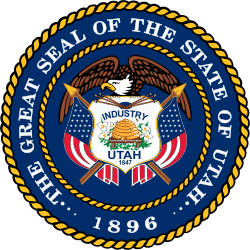Utah Territory
The Territory of Utah was an organized incorporated territory of the United States that existed from September 9, 1850, until January 4, 1896, when the final extent of the territory was admitted to the Union as the State of Utah,[1] the 45th state.
| Territory of Utah | |||||||||
|---|---|---|---|---|---|---|---|---|---|
| Organized incorporated territory of the United States | |||||||||
| 1850–1896 | |||||||||
.jpg) Territorial coat of arms (1876)
| |||||||||
 The Utah Territory upon its creation, with modern state boundaries shown for reference | |||||||||
| Capital |
| ||||||||
| Government | |||||||||
| • Type | Organized incorporated territory | ||||||||
| Governor | |||||||||
• 1851–1858 | Brigham Young | ||||||||
• 1875-1880 | George W. Emery | ||||||||
• 1880-1886 | Eli Houston Murray | ||||||||
• 1886-1889, 1893–1896 | Caleb Walton West | ||||||||
| Legislature | Utah Territorial Assembly | ||||||||
| History | |||||||||
| 1849 | |||||||||
• Utah Organic Act | September 9 1850 | ||||||||
• Colorado Territory formed | February 28, 1861 | ||||||||
• Nevada Territory formed | March 2, 1861 | ||||||||
• Wyoming Territory formed | July 25, 1868 | ||||||||
| January 4 1896 | |||||||||
| |||||||||
Background
| Year | Pop. | ±% |
|---|---|---|
| 1850 | 11,380 | — |
| 1860 | 40,273 | +253.9% |
| 1870 | 86,336 | +114.4% |
| 1880 | 146,608 | +69.8% |
| 1890 | 210,779 | +43.8% |
| Source: 1850–1890[2] | ||
The territory was organized by an Organic Act of Congress in 1850, on the same day that the State of California was admitted to the Union and the New Mexico Territory was added for the southern portion of the former Mexican land. The creation of the territory was part of the Compromise of 1850 that sought to preserve the balance of power between slave and free states. With the exception of a small area around the headwaters of the Colorado River in present-day Colorado, the United States had acquired all the land of the territory from Mexico with the Treaty of Guadalupe Hidalgo of 1848.
The creation of the Utah Territory was partially the result of the petition sent by the Mormon pioneers who had settled in the valley of the Great Salt Lake starting in 1847. The Mormons, under the leadership of Brigham Young, had petitioned Congress for entry into the Union as the State of Deseret, with its capital as Salt Lake City and with proposed borders that encompassed the entire Great Basin and the watershed of the Colorado River, including all or part of nine current U.S. states. The Mormon settlers had drafted a state constitution in 1849 and Deseret had become the de facto government in the Great Basin by the time of the creation of the Utah Territory.[3]
Following the organization of the territory, Young was inaugurated as its first governor on February 3, 1851. In the first session of the territorial legislature in September, the legislature adopted all the laws and ordinances previously enacted by the General Assembly of the State of Deseret.
Mormon governance in the territory was regarded as controversial by much of the rest of the nation, partly fed by continuing lurid newspaper depictions of the polygamy practiced by the settlers, which itself had been part of the cause of their flight from the United States to the Great Salt Lake basin after being forcibly removed from their settlements farther east.
Although the Mormons were the majority in the Great Salt Lake basin, the western area of the territory began to attract many non-Mormon settlers, especially after the discovery of silver at the Comstock Lode in 1858. In 1861, partly as a result of this, the Nevada Territory was created out of the western part of the territory. Non-Mormons also entered the easternmost part of the territory during the Pikes Peak Gold Rush, resulting in the discovery of gold at Breckenridge in Utah Territory in 1859. In 1861 a large portion of the eastern area of the territory was reorganized as part of the newly created Colorado Territory.[3]
In 1869 the territory approved and ratified women's suffrage.[4]
The controversies stirred by the Mormon religion's dominance of the territory are regarded as the primary reason behind the long delay of 46 years between the organization of the territory and its admission to the Union in 1896 as the State of Utah, long after the admission of territories created after it. In contrast, the Nevada Territory, although more sparsely populated, was admitted to the Union in 1864, only three years after its formation, largely as a consequence of the Union's desire to consolidate its hold on the silver mines in the territory. Colorado was admitted in 1876.

See also
References
- "Utah". World Statesmen. Retrieved July 20, 2015.
- Forstall, Richard L. (ed.). Population of the States and Counties of the United States: 1790–1990 (PDF) (Report). United States Census Bureau. pp. 3–4. Retrieved May 18, 2020.
- Alford, Kenneth L. (2017). Utah and the American Civil War: The Written Record. University of Oklahoma Press. p. 801. ISBN 978-0-8061-5916-4.
- Lemay, Kate Clarke; Goodier, Susan; Tetrault, Lisa; Jones, Martha (2019). Votes for Women: A Portrait of Persistence. Princeton University Press. p. 270. ISBN 9780691191171.
Further reading
- Unpopular Sovereignty: Mormons and the Federal Management of Early Utah Territory by Brent M. Rogers, 2017, University of Nebraska Press
External links
| Wikimedia Commons has media related to Utah Territory. |
- Utah in 1851, with the text of the 1850 Act of Congress to Establish the Territory of Utah, Central Pacific Railroad Photographic History Museum
- Utah's Role in the Transcontinental Railroad, Central Pacific Railroad Photographic History Museum
- Utah State History Utah Office of Tourism Official Website
- Henry Sommer, Watercolors and Pencil Drawings Related to the Utah Expedition. Yale Collection of Western Americana, Beinecke Rare Book and Manuscript Library.
